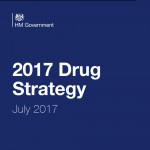Search Result
More drugs
Drug Strategy 2017
The word 'chemsex' is mentioned four times in a short paragraph, part a 52-page strategy document:
"Chemsex is a term for the use of drugs before or during planned sexual activity to sustain, enhance, disinhibit or facilitate the experience. Chemsex commonly involves crystal methamphetamine, GHB/GBL and mephedrone, and sometimes injecting these drugs (also known as slamming). Chemsex carries serious physical and mental health risks including the spread of blood-borne infections and viruses. PHE will support local areas to meet these needs by promoting and publishing guidance on effective practice, including targeted interventions and close collaboration between sexual health services and other relevant services including community groups."
Some argue the fact that the harms of chemsex are mentioned at all is a win, and while Public Health England has done work on the issue, it just seems like small change against the turmoil of recent years including research last year (2016) reporting a 119% increase in deaths associated with GHB/GBL in London with most linked to chemsex. That’s about 1 gay man dying every 12 days in the capital.
It’s disappointing there’s no mention of gay men and men who have sex with men, or a wider LGBT focus, at all. This was included in the 2010 Strategy (with a note that treatment services should consider the needs of LGBT groups). The importance of services speaking directly to specific communities is widely recognised, particularly when addressing problematic chemsex drug use, discussing sexual behaviour openly and addressing the multiple stigmas that accompany drug use, HIV, gay sex and sexual identity. Bottom line: we at MEN R US think the strategy is a missed opportunity though the short paragraph does provide some opportunity to refer back to the strategy when pushing for better services for chemsex users.
2017 Drug Strategy | Home Office | July 2017
Response to the 2017 Drug Strategy by the English Harm Reduction Group
The Government has now published the 2017 Drug Strategy. We express great concern at the lack of focus on harm reduction - an evidence-based response that protects people and ultimately saves lives - at a time when drug-related deaths are the highest on record.
- Heroin and morphine deaths rose by 109 percent in the England and Wales between 2012 and 2016ii, when the evidence is overwhelming that harm reduction initiatives can reduce them. Initiatives such as opioid substitution treatment (OST) and needle and syringe programmes are only mentioned fleetingly within the Strategy, and others such as drug consumption rooms and heroin assisted therapy (HAT) are completely absent.
- It is appalling that the Government acknowledges in the strategy that the rise in drug-related deaths is ‘dramatic and tragic’, but proposes no concrete action plan to reduce them. For example, the strategy comments on the importance of naloxone to prevent overdose deaths but proposes no national systematic approach to naloxone provision, nor any new funding for this vital intervention. It is shocking that whilst drug-related deaths have outstripped both road traffic fatalitiesiii and deaths from blood borne virusesiv,v, there is no coordinated response from central government.
- This erosion of services continues against a backdrop of funding for all drug services being continuously reduced. Public health spending has reduced by more than 5% since 2013vi, and according to analysis a further £22 million in cuts are to made for drug treatment by the end of 2017/18vii. Without funding drug services will not be able to function effectively.
- The Government has dismissed decriminalisation of drug possession offences as being simplistic. Yet the World Health Organisation and a multitude of United Nations agencies have called for the end of criminal sanctions for possession and use of drugs in recognition that criminalisation creates barriers to those needing treatment and increases health harms.
People who use drugs are often vulnerable and marginalised. This new Drug Strategy simply does not begin to support them and reduce drug-related deaths. We call on the Government to implement the recommendations of the Advisory Council on the Misuse of Drugs to tackle opiate related deaths, these include: optimal OST prescribing; easier access to naloxone; a national HAT programme; and that drug consumption rooms are implemented where there is needviii. The Government must also ensure a minimum level of care by requiring local authorities to provide drug treatment and harm reduction services by law.
Signatories: Professor David Nutt, Drug Science; Niamh Eastwood, Release; Deborah Gold, National AIDS Trust; John Jolly, Blenheim CDP; Fionnuala Murphy, Harm Reduction International; Kate Halliday, SMMGP; Jamie Bridge, International Drug Policy Consortium; Chris Ford, IDHDP
Response to the 2017 Drug Strategy | English Harm Reduction Group
Chemsex drugs and former legal highs targeted by Home Office | The Guardian | 14 Jul 2017
Don’t believe the hype: the new drugs strategy ignores the LGBT Community | Vice | 28 Jul 2017
↑ Back to top


